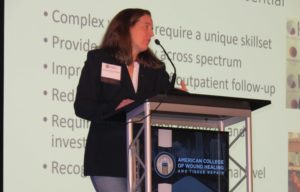
Inpatient wound services are an essential component of care that can improve the likelihood of patients returning as outpatients, thereby reducing readmissions, Christi Cavaliere (Cleveland Clinic, Cleveland, USA) told the annual meeting of the American College of Wound Healing and Tissue Repair (ACWHTR 2019; 11-12 October, Chicago, USA), in a lecture on plastic surgery and wound care.
Cavaliere was outlining her institution’s creation of a surgical wound care service in 2013, a centre that started out life with a team that included the plastic surgeon herself and a nurse practitioner.
Often, the Cleveland Clinic’s medical director of wound care explained, patients can find themselves jammed in a revolving door between outpatient and inpatient, creating a conundrum as to where they should end up for wound care.
“I think connecting surgical and non-surgical care is really important for our patients. From a big picture standpoint, we need a system that takes advantage of the skills of the wound nurse, the surgeon and the non-surgeon wound care provider,” said Cavaliere. “We are all in this for the patient, and we already know that coordinated care is going to lead to better outcomes.”
She added: “I think the wound centre has done a great job in creating a model of outpatient care for these patients and providing the comprehensive management that they need. Inpatient care needs to evolve in this direction as well.”
In Cleveland, the new centre also involved the establishment of a wound fellowship. Cavaliere described the coming together of the disparate elements. “We engaged the hospitalists, the wound nurse team, and then we have the people I like to think of as the wound village, which is the orthopedic surgeons, the urologists, the vascular surgeons, all of the people that need to work together,” she said.
“For the most part, if a designated team is willing to own the overall care of the patient, the other consultants are willing to participate because they know they can do their part, and the team will take care of the rest.” The system sees Cavaliere and her team attend to somewhere in the vicinity of 500 unique inpatients per year.
“We have greatly improved direct communication and the wound photos that we integrated in our electronic medical record (EMR) have been helpful because the wound nurses photograph the pressure ulcers weekly,” Cavaliere continued. “And we have the ability to take pictures of other wounds and upload those as well to provide continuity of care.
“I think we have done a good job of being more proactive with the operating room. There is nothing more frustrating than going to the ICU, and seeing somebody with a wound in need of debridement -who was in the OR yesterday for something else. That doesn’t make sense.
If you are going to the OR for something else we can take care of debriding the wound at the same time, and that has been a benefit for our patients.”
Surgical options are necessary, Cavaliere said, in order that individuals might see better outcomes. As in the case of one prior wound patient, she describes to demonstrate her point: “I met this gentleman during an admission for other medical issues, got him set up for outpatient pressure ulcer debridement, bone biopsies, and we treated him with six weeks of antibiotics. We went back and closed the first side with a flap, and about three months later we went back and closed the second side. So this gentleman is now working, he has a family, and we put him in a situation where he does not need dressing changes and wound care appointments.”
The Cleveland experience may offer lessons for others, Cavaliere said. “I think that the inpatient wound service is essential. It might not be something that you can really develop in the same way or even should in a smaller community hospital, but I do think that as hospital systems merge, and you have bigger centres where the complicated patients are concentrated, I think that this is really something that we need.”
Cavaliere added: “I do think that we can improve the likelihood of these patients coming back as an outpatient, and I think that will reduce readmissions. This requires institutional resources and investment, and I think we need to recognise this at a national level.”











